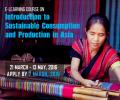The ILO strategy for the green jobs programme includes producing a comprehensive knowledge base, tested tools and practical approaches, a strong team from various ILO units and offices, the full involvement of the ILO constituents, strategic partnerships and the pooling of resources to achieve shared goals. The Green Jobs web...


Green Growth is a policy focus for the Asia and Pacific region that emphasizes environmentally sustainable economic progress to foster low-carbon, socially inclusive development. These videos give insights on what green growth exactly means and how it can be achieved.
This website supports the creation and implementation of country-driven, analytically rigorous low emission development strategies (LEDS). LEDS will enable countries to transition to low carbon economic development resulting in sustained growth in employment and investment, increased financial flows through carbon markets, reduced greenhouse gas (GHG) emissions, and other social, economic...
The LEDS toolkit presented on this website provides information on available datasets, studies, tools, and other technical resources to support the LEDS process. The customized search boxes below allow users to search tools and programs in relation to relevant questions, sector, geography, LEDS methodology stage, analytical needs, and other search...
As the world’s most populous region and the most vulnerable to climate risks, Asia is at the centre of a paradigm shift towards low carbon green growth. This shift must incorporate economic and social inclusion, and environmental sustainability in the strategic policy making and implementation. Many developing Asian economies have started this paradigm shift, bringing clean energy access to poor, stressing industrial competitiveness, developing green technology markets, and supporting decent job generation. What has been the initial experience with the paradigm shift? What can policy-makers learn from the experience and further advance the policy agenda? How can an action focussed approach be structured to support the continuing policy learning and advancement?

For policy makers in China, the development of a green economy presents opportunities and challenges not only for the central government, but also for provincial and city governments. This study measures clean energy economy at the city level in China, by counting green jobs and firms through an analytical approach. As shown in this study, green jobs and green firms are distributed unevenly across different regions in China. This study also quantifies provincial clean energy policies in China and finds significant variations in clean energy policy actions. Spatial error model (SEM) analyses indicate that local clean energy policies, along with socio-economic factors such as population, per capita gross domestic product, educational attainment, emissions of sulfur dioxide, and marketization of the regional economy, explain the variation in green economy across cities. Cities located in a province with clean energy policies have 54.3% more green jobs and 61.8% more green businesses, compared with cities located in a province without such policies.
The Multimedia Section on the Global Green Growth Institute offers several informative videos on the work of GGGI, on green economy and green economy related topics. Some examples are the COP19 videos, interviews with Green Economy experts and policy makers and introductory videos to the topic of green economy.
